
Did you guys ever read a Wrinkle in Time by Madeline L. Engle? Written around 1960, Engle crafts such a tripped-out, interplanetary space exploration (complete with quantum physics) it still gets my gears turning to this day. Not surprisingly, Engle sent her novel to about 30 publishers who found the book too "different" to publish; but when the book finally hit the shelves in 1962 it won a slew of awards including the Newbery Medal, Sequoyah Book Award and a Lewis Carroll Shelf Award.
Oh, and did I mention it has a female protagonist? In a science fiction fantasy book? Which to this day is still an anomaly? (Don't even get me started on women writing science fiction.)
Anyway, Engle's book focused on the concept of tesseracts or "hypercubes"—a geometric form of a cube within a cube—which basically act like wormholes; the book's premise is that in order to travel through time swiftly, you've got to "wrinkle it," collapsing the space between two points.
The idea of traversing the space-time continuum alongside my intergalactic pals is a desire that continues to thump in my chest, so the recent attention given to the possibility of actual wormholes has captured my attention all over again.
Here's the lowdown: Einstein's theory of relativity allows for the possibility of wormholes; he basically describes gravity as a phenomenon that warps space and time. If gravity can ruffle the proverbial feathers of spatial fabric, maybe wormholes could too.
Theories on these wonderful wormholes—which basically would allow people, places and things to traverse otherwise impossible distances in space—date all the way back to 1935, published by (shocker!) Einstein and Nathan Rosen. Their theory was first dubbed the Einstein-Rosen bridges. Sadly, while these "bridges" were possible, they collapsed too quickly and were too tiny for anything—even light—to pass through to the other side. Popping over to another galaxy for tea was out of the question.
Cosmos darling Carl Sagan circled back to the concept however in the '80s while working on his novel Contact (which boasts another leading lady who traipses across the universe) seeking out physicist Kip Thorne to see if his protagonist could actually make the journey he'd imagined for her.
Thorne thought it over and believed a wormhole was the best option, but they'd need to address the whole "too-tiny" "too-fast" problem. His solution? Exotic matter. A hypothetical particle that "deviates from the norm"—basically, it defies all notions of physics because it has negative mass, acting almost like antigravity:
Negative mass would possess some strange properties, such as being repelled rather than attracted by gravity and accelerating in the direction opposite of applied force. For example, an object with negative inertial mass and positive electric charge would accelerate away from objects with negative charge, and towards objects with positive charge, the opposite of the normal rule that like charges repel and opposite charges attract. — Wikipedia, Exotic Mass.
But it's this bizarro-world behavior that would prevent said wormhole from collapsing. The basic idea is to wrap positive energy around negative energy thus creating a hole where we could all head over to Pluto. Sounds great, right? Here's the bad news:
The problem is that for such a wormhole, you would need more negative energy than the rules allow. And even if you could break the rules, you would need an enormous amount. As a very rough approximation, you would need the energy the sun produces over 100 million years to make a wormhole about the size of a grapefruit. No one knows how even an advanced civilisation could access that much negative energy. — Marcus Woo, BBC.com
Happily, there are still physicists dedicating their brainpower to space-time travel. Now we've just got to hope they'll let female astronauts lead that journey.






